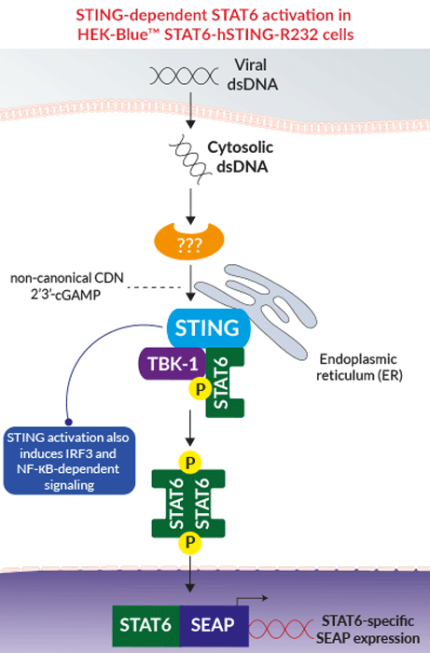HEK-Blue™ STAT6-hSTING-R232 Cells
-
Cat.code:
hkb-st6r232
- Documents
ABOUT
Human STING-dependent STAT6 reporter HEK293 cells
HEK-Blue™ STAT6-hSTING-R232 cells are specifically designed to monitor the induction of STAT6-dependent signaling upon activation of STING. These cells were generated by stable overexpression of the most prevalent human (h)STING variant R232 [1], in a human embryonic kidney (HEK)293-derived cell line that expresses human STAT6 and a STAT6-inducible secreted embryonic alkaline phosphatase (SEAP) reporter. STAT6-dependent SEAP activity is readily assessable in the supernatant using QUANTI-Blue™ Solution, a detection reagent.
STING Background
STING (stimulator of interferon genes) is essential in the effective immune response against foreign or self-DNA through the sensing of cytoplasmic cyclic dinucleotides (CDNs) [2]. The activation of STING causes a TANK-binding-kinase-I (TBK1)-dependent cascade, ultimately, leading to IFN regulatory factor (IRF3)-dependent type I IFN production and NF-κB-dependent inflammatory cytokine production [2]. Additionally, signal transducer and activator of transcription 6 (STAT6) has been reported to be recruited to STING for TBK1-mediated phosphorylation during viral infection [3]. Ultimately, the STING‑dependent activation of STAT6 induces a specific set of anti-viral chemokines responsible for immune cell homing, which leads to reduced viral replication [3]. Notably, this specific 'viral' activation of STAT6 was found to be Janus kinase (JAK)-independent and is thus, distinct from the ‘canonical’ STAT6 pathway activated by IL-4 and IL-13, which is critical in adaptive immunity [3].
Features of HEK-Blue™ STAT6-hSTING-R232 cells:
- Verified overexpression of hSTING (PCR and functional assays)
- Functionally validated with a selection of STING ligands
- These cells do not respond to Type I IFNs
- Readily assessable STAT6-dependent SEAP reporter activity
- The stability for 20 passages has been verified
- Guaranteed mycoplasma-free
Applications for HEK-Blue™ STAT6-hSTING-R232 cells:
- Studying the role of STING-dependent STAT6 activation in response to viral infection
References:
1. Yi, G. et al. 2013. Single nucleotide polymorphisms of human STING can affect innate immune response to cyclic dinucleotides. PLoS One 8, e77846.
2. Cheng, Z. et al. 2020. The interactions between cGAS-STING pathway and pathogens. Signal Transduct Target Ther 5, 91.
3. Chen, H. et al. 2011. Activation of STAT6 by STING is critical for antiviral innate immunity. Cell 147, 436-446.
Disclaimer: These cells are for internal research use only and are covered by a Limited Use License (See Terms and Conditions). Additional rights may be available.
SPECIFICATIONS
Specifications
STING
Human
STING activation cellular assays
Complete DMEM (see TDS)
Verified using Plasmotest™
Each lot is functionally tested and validated.
CONTENTS
Contents
-
Product:HEK-Blue™ STAT6-hSTING-R232 Cells
-
Cat code:hkb-st6r232
-
Quantity:3-7 x 10^6 cells
- 2 x 1 ml of HEK-Blue™ Selection (250x concentrate)
- 1 ml of Normocin™ (50 mg/ml)
- 1 ml of QB reagent and 1 ml of QB buffer (sufficient to prepare 100 ml of QUANTI-Blue™ Solution)
Shipping & Storage
- Shipping method: Dry ice
- Liquid nitrogen vapor
Storage:
DOCUMENTS
Documents
Technical Data Sheet
Validation Data Sheet
Safety Data Sheet
Certificate of analysis
Need a CoA ?



